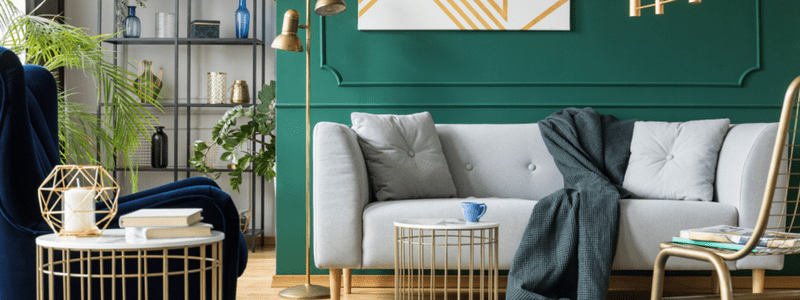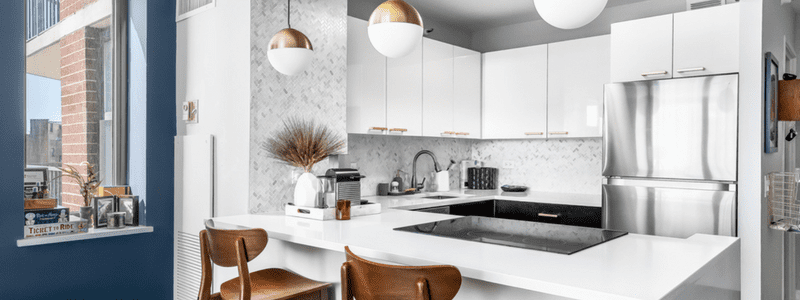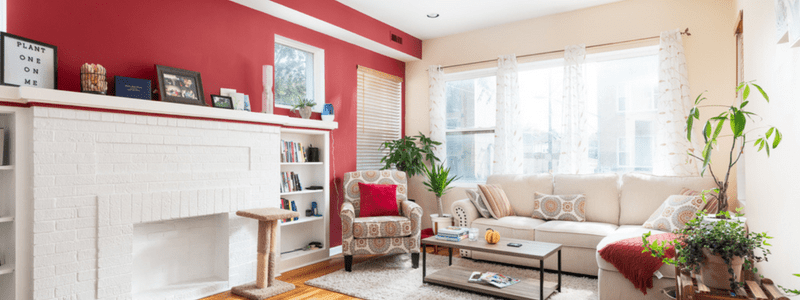An accent wall is an ideal method for acquainting a new look to a room without focusing on the whole room’s worth of color.
Accent walls are very stylish and will look astounding pretty much in any room.
In a flash, they cause a room to “pop” and ultimately help express you as a homeowner. Accent walls can be an incredible extension to a home makeover. They are very easy to do, don’t require a lot of money, nor do professionals cost too much if you want/need help. Yet, they should be executed the correct way or risk feeling like they stick out like a sore thumb.
When approaching the task of painting an accent wall, there is a good amount of consideration you will need to put into place; what wall to put it on, selecting the best colors, etc.
So, if you are pondering whether to paint an accent wall but don’t know how or what to do, here are some accent wall rules of thumb to get you started.

What is an Accent Wall?
An accent wall is a solitary wall in a room that is deliberately painted in a different color variety compared to the rest of the space, to separate itself. To set the room apart for the rest.
An accent wall will typically become the ultimate focal point of the room. They can also cause a space to seem bigger and more extensive than it really is. This can be a tremendous advantage when the measured area’s size is a worry of yours.
Accent walls can be utilized in any space in your home. They are used in kitchens, living rooms, offices, bathrooms, etc.
Choosing an Accent Wall
One of the first accent wall rules of thumb is to pick the accent wall.
Picking the right wall as your accent wall is the initial step to an attention-getting accent wall.
Try to avoid using the smaller rooms in your home. Accent walls tend to look their absolute best in well-lit, open spaces.
An unfortunate accent wall decision could mean the difference between a room that is professional and a room that simply looks like it doesn’t belong.
Whichever wall you pick, be certain there’s motivation to draw someone’s attention to the accent. But how will you know where to put an accent wall? Where is the best placement?
Consider the Focal Point of the Room
When deciding your accent wall location, one thing you should consider is the natural focal point of the room. Where do your eyes naturally fall upon entering?
The right wall to accent is usually the first one that you see when you enter a room.
Focal points for accent walls include:
- The shorter walls in a rectangular room
- The wall facing the entrance
- A wall with natural light
- The wall with the headboard of your bed
- Walls with interesting architectural designs like certain trims and fireplaces
- Walls behind unique artwork or furniture
If your room lacks any substantial focal point, try to create one. This is where you can let your imagination shine and creativity flow. Allow the furniture and decor of your home to help you create a natural focal point for your room.

Creating a Focal Point
Think about things that stand out or help make a room stand out. That should help you create focal points for an accent wall – things like:
- Indoor house plants
- Framed family pictures
- Unique furniture
- Lamps/track lighting
When considering a wall for painting, make sure that you avoid walls with large furniture or windows. This will take away from the point of your accent wall and can end up with your room looking smaller. Make sure to utilize the ceiling as well.
If colors don’t seem to be coming together, adding some ceiling color can shake the look up.
Choosing The Right Color
When choosing the best color for your accent take a look at your current color scheme. Choosing shades of that color for ease in picking. Also, using the little accent colors from throw pillows, furniture, artwork, and other items in your space.
You can use color to your advantage. Certain colors will make a short wall seem long or a long wall seem short.
The right color may even come from considering the function of the room you’re decorating. Different colors evoke different emotions. The color blue is seen as more relaxing/calming whereas red is energetic.
To maintain a more neutral tone, using tans and browns keeps the space looking natural in color.
In order to not overpower your room’s color scheme, professionals use a little rule called the 60-30-10 wall color rule to maintain the space’s color balance.
Simply put, 60% of your room will have the dominant color, 30% should primarily be the secondary color, and 10% the accent color.
Think About The Other Wall Colors
Lastly, think about the other wall colors when considering your accent wall. A color clashing accent wall is a big bummer you don’t want to run into.
Accent walls tend to look their best when they connect the walls color in a scale from light to medium in shade.
Blend your bold accent wall color with more neutral colors like brown, gray, or beige.

Colorado Painting: Interior Painting Professionals
Having an accent wall can be very transformative for the way your house looks and can give your home new life. Though, as you probably know, painting can be one heck of a process (and mess).
Having a clean, dependable, and legitimate painting company will grant you peace of mind in a timely manner, allowing you to know that the painting will be done appropriately and with utmost meticulousness.
We can reduce your expenses by wiping out errors that frequently go with Do-It-Yourself paint projects.
At Colorado Painting, our knowledge in various paint styles, varieties, etc. makes us the specialists you’ll want for any interior painting job.
Schedule a free estimate, where we can also give you painting tips – just like these accent wall rules of thumb.































